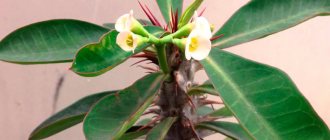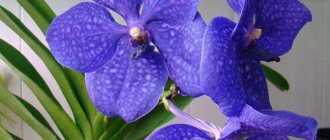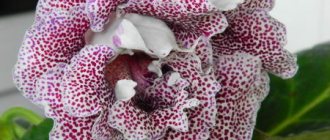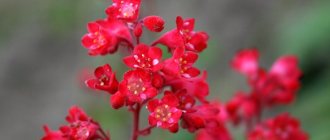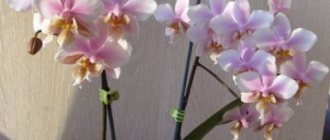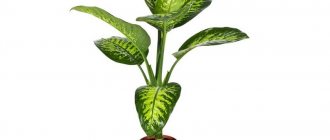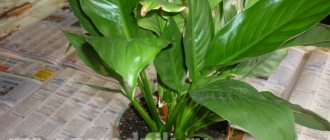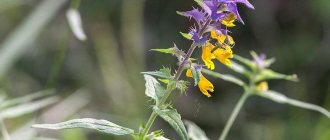family of flowering plants
| Ranunculaceae Time range: 145–0 PreꞒ Page N Early Cretaceous–Recent[1] | |
| Ranunculus auricomus | |
| Scientific classification | |
| Kingdom: | Plantae |
| Clade : | Tracheophytes |
| Clade : | Angiosperms |
| Clade : | Eudicots |
| Order: | Ranunculales |
| Family: | Buttercup Juss. |
| Type genus | |
| Ranunculus | |
| Subfamilies | |
| |
Ranunculaceae
(
ranunculus
or
sparrow family
; Latin ranunculus "frog", from rana "frog") a family of over 2,000 known species of flowering plants in 43 genera,[2] distributed throughout the world.
The largest genera Ranunculus
(600 species),
Delphinium
(365),
Thalictrum
(330),
Clematis
(325), and
Aconitum
(300).
Notes
- For the convention of indicating the class of dicotyledons as a superior taxon for the group of plants described in this article, see the section “APG Systems” of the article “Dicotyledons”.
- Information about the genus Ranunculus
Index Nominum Genericorum
database of the International Association for Plant Taxonomy (IAPT). - Flora of the USSR, 1937.
- Barabanov E.I.
Botany: a textbook for students of higher educational institutions. - M.: Publishing House, 2006. - P. 237. - 448 p. — ISBN 5-7695-2656-4. - Andreeva I. I., Rodman L. S.
Botany. — 3rd, revised. and additional - M.: Kolos, 2005. - P. 396. - 528 p. — ISBN 5-9532-0114-1. - Ranunculus
(English). The Plant List. Version 1.1. (2013). Retrieved August 4, 2022.
Barnyard grass (amaranth family)
Pollination by pollen
The anthers begin to mature with the stamens forming the outer circle, gradually reaching the stamens that are adjacent to the carpels. Since immature stamens protect the carpels, the flower cannot self-pollinate during the first time after opening. Pollen reaches the stigma only after the stamens of the inner circle have matured. Self-pollination can also be prevented by protogyny.
In warm weather, the walls of the carpels secrete large amounts of nectar. Due to protogyny, seeds are usually not produced. Early insects (flies, bees) obtain nectar without touching the stigmas, so cross-pollination is impossible. Ranunculaceae are practically not pollinated by the wind.
Larkspur
Umbrella family: characteristics and representatives
When talking about field larkspur, several names are used: horned cornflower, larkspur.
It grows, as a rule, among winter crops, less often among spring crops. Clumps of larkspur can also be found in fallow fields.
The flower is irregular, blue-violet, with spurs. They are located on the stem in the form of a sparse branched brush. The perianth is represented by two colored sepals and two petals. Pollination is cross-pollination, with the participation of insects with long proboscis. With their help, they get nectar from the spur. The stem is branched and can reach a height of 30 cm. The leaves are trifoliate with linear lobes. The fruit is a leaflet. The seeds are dark gray in color and can reach 2-5 mm in length. On the outside they are covered with thin scales. They have a bitter taste and poisonous properties. Cases of larkspur poisoning are common in sheep.
Chinese swimsuit
Homeland - Far East, Sakhalin, China. Chinese swimsuit belongs both to the group of coastal plants used in the design of reservoirs, and to ground-blooded plants, that is, for the design of lawns. This perennial herbaceous plant of the Ranunculaceae family, the height of its stems reaches 70-90 cm, has a beautiful rosette of basal leaves.
The leaves are ornamental, three to five separate, shiny dark green. The flowers are solitary, large, up to 5 cm in diameter, orange in color. Flowering begins in June and lasts about three weeks.
The seeds ripen in August, and they are used to propagate the Chinese Swimsuit. The plant is frost-resistant, moisture-loving, grows well both in open areas and in partial shade. To grow Chinese Bathing Suit, the soil must be nutritious and well fertilized, moist with the addition of peat.
Without replanting, the plant grows in one place for up to six years. Chinese swimsuit is planted in damp places, in groups and ridges.
Ranunculaceae family
The Ranunculaceae family includes dicotyledonous, free-petalled flowering plants. This group of plants includes approximately 50 genera and more than two thousand plant species, which grow mainly in areas with temperate and cold climates on all continents of the Earth. Ranunculaceae are found in the extratropical zone of the Northern Hemisphere. In the tropics and subtropics, plants of this family grow only in high mountain areas
The Ranunculaceae family occupies an important place in the flora of the Arctic, despite the fact that the number of species here is small (about 13 genera).
Representatives of the buttercup family are herbaceous plants; they can be annual, biennial or perennial. Rare species are subshrubs or climbing shrubs, for example, plants of the genus Clematis.
The vast majority of species of the ranunculaceae family require sufficient, sometimes excessive, moisture
In some cases, good moisture is only necessary at the beginning of the growing season. An essential factor for the survival of buttercups in the far north is reliable protection in winter by snow cover. Among the buttercups there are aquatic plants.
Characteristics of the ranunculaceae family are given below. In most plants of this group, the root system is represented by rhizomes; stolons can form; there are thickened roots in which nutrients are stored. The stem is herbaceous, the woody structure is characteristic exclusively of the genus Clematis.
Ranunculaceae leaves can be simple (whole) or complex (palmate, pinnately dissected) in different species. Stipules are absent. The arrangement of leaves is alternate, only in species of the genus Clematis it is opposite. Some species have only basal leaves, while others, in addition to them, also have stem leaves.
Flowers of the Ranunculaceae family are bisexual, less often unisexual, regular (with perianth). They are collected in inflorescences - brushes or panicles; sometimes the flowers are located singly at the top of the stem or in the axils of the leaves. A typical Ranunculaceae flower has characteristic features. The corolla has five petals, five sepals, numerous stamens and pistils arranged in a spiral on the receptacle. Flowers of some species exhibit deviations from the typical structure. Petals can be modified, variations in the number of stamens, pistils, and sepals are possible. The color of the flower corollas is varied - yellow, red, blue, white. Pollination of flowers of most species is carried out by insects, which are attracted to them by nectar.
The fruit of buttercups is a composite, consisting of multi-seeded leaflets or achenes. In rare species the fruit is a capsule or berry. In the seed, the protein occupies a larger proportion, and the embryo occupies a smaller proportion. The fruits are carried by wind, water, and animals.
The importance of plants from the buttercup family in the natural environment and human life is very great. Many of them are medicinal plants, for example, adonis, basilisk, sleep grass, hellebore. This is due to the fact that different active substances are found in different parts of plants. Aboveground shoots and leaves of buttercups contain various flavonoids, and in lower concentrations – essential oils, saponins, resins, and tannins. The seeds are rich in fatty oils. Ranunculus plants from one group contain anemolol, from another - cardenolides, from the third - alkaloids. Most buttercup plants are poisonous to animals and humans.
Many ranunculus plants are ornamental due to their brightly colored flower corollas, for example, leotard, coppice, larkspur, anemone, clematis, etc. These species are cultivated by humans.
Bibliography
- Clapham, AR.; Tutin, T.G.; Warburg, E. F. (1981). Excursion Flora of the British Isles
(3rd ed.). Cambridge, UK: Cambridge University Press. ISBN 978-0521232906.CS1 maint: ref=harv(communication):25 - Stace, K.A. (2010). The New Flora of the British Isles
(3rd ed.). Cambridge, UK: Cambridge University Press. ISBN 9780521707725.CS1 maint: ref=harv(communication):101 - Ronse de Cresnais, L.P. (2010). Floral diagrams, an aid to understanding the morphology and evolution of flowers
. Cambridge University Press. ISBN 9780521729451.CS1 maint: ref=harv(communication):140 - Christenhuis, M. J. M.; Bing, J. W. (2016). "The number of known plant species in the world and its annual increase." Phytotax
.
261
(3):201–217. Doi:10.11646/phytotaxa.261.3.1.CS1 maint: ref=harv (link) - Langlet, O. (1932). Uber Chromosomenverhaltnisse und Systematik der Ranunculaceae. Svensk Bot. Tidskr 26, 381–401.
- PNG (2016). "Updated classification of the angiosperm phylogenetic group for orders and families of flowering plants: APG IV". Botanical Journal of the Linnean Society
.
181
(1):1–20. Doi:10.1111/boj.12385.CS1 maint: ref=harv (communication) - Keener, Carl S.; Open, James L.; Dutton, Brian E.; Ziman, Svetlana (August 1999). "List of suprageneric names of buttercups (Magnoliophyta)". Taxon
.
48
(3): 497. doi:10.2307/1224562. JSTOR 1224562. - Kubicki, Klaus; Rohwer, Jens G.; Bittrich, Volker, eds. (1993). Families and genera of vascular plants.
II Flowering plants - Dicotyledons. Families Magnoliaceae, Hamamelidaceae and Caryophyllidae . Berlin: Springer. ISBN 978-3540555094. - Pigg, K. B.; Devore, M. L. (October 1, 2005). “The fruits of Paleoactaea gen. Nov. (Ranunculaceae) from the Paleogene of North Dakota and London Clay." American Journal of Botany
.
92
(10):1650–1659. Doi:10.3732/ajb.92.10.1650. PMID 21646082.CS1 maint: ref=harv (communication) - Stevens, P.F. (2017) [2001], Angiosperm Phylogeny Website
, Missouri Botanical Garden, retrieved April 13, 2015CS1 maint: ref=harv (link) - Sandro Pignatti. Flora d'Italia
, Edagricole, Bologna, 1982. (in Italian) ISBN 88-506-2449-2 - Tamura, M (1993-07-28). Ranunculaceae
. pp. 563–583. ISBN 9783540555094, in Kubicki et al. (1993) - Strasburger, Noll, Schenck, Schimper: Lehrbuch der Botanik für Hochschulen. 4. Auflage, Gustav Fischer, Jena 1900, p. 459 (floral schemes)
- Kumazawa, Masao (1938). "Systematic and phylogenetic consideration of Ranunculaceae and Berberidaceae". Shokubutsugaku Zasshi
.
52
(613): 9–15. Doi:10.15281/jplantres1887.52.9.CS1 maint: ref=harv (communication) - Emadzadeh, Khatereh; Lenebach, Carlos; Lockhart, Peter; Elvira, Horundle (June 2010). "Molecular phylogeny, morphology and classification of the genera Ranunculeae (Ranunculaceae)" (PDF). Taxon
.
59
(3):809–828. Doi:10.1002/tax.593011. - Wang, Wei; Lu, An-Ming; Ren, Yi; Endress, Mary E.; Chen, Zhi-Duan (January 2009). "Phylogeny and classification of Ranunculales: evidence from four molecular loci and morphological data". Perspectives on plant ecology, evolution and systematics
.
11
(2): 81–110. doi:10.1016/j.ppees.2009.01.001. - Turner, NJ (July 1984). "Anti-irritant and other medicinal uses of Ranunculaceae plants by indigenous peoples of British Columbia and neighboring territories." Journal of Ethnopharmacology
.
11
(2): 181–201. Doi:10.1016/0378-8741(84)90038-2. PMID 6387285.CS1 maint: ref=harv (communication) - Whittemore, Alan T.; Parfitt, Bruce D. (1997). "Buttercups." In Flora of the North American Editorial Committee (ed.). Flora of North America north of Mexico (FNA)
.
3
. New York and Oxford through eFloras.org, Missouri Botanical Garden, St. Louis, MO and Harvard University Herbaria, Cambridge, MA. - List of Plants (2013). "List of plants Version 1.1." Royal Botanic Gardens, Kew and Missouri Botanic Gardens. Retrieved July 7, 2015.CS1 maint: ref=harv (communication)
Advantages
It is worth noting that buttercups have many useful properties and advantages compared to other ornamental flowering plants.
- Medicinal properties. Many types of buttercups are used in folk medicine. On their basis, tinctures and ointments are prepared, and the juice of the plant is also used for medicinal purposes.
- Resistance to diseases and pests. Of all the known misfortunes, buttercups are susceptible to powdery mildew. But this rarely happens, since buttercups are accustomed to dampness and react to waterlogged soils very tolerantly.
- Easy to care for. If you decide to plant a buttercup in your summer cottage, then you don’t need to worry whether your care will be enough for it.
- Easily propagated. It is enough to simply grow at home from seeds or tubers. And in the wild, seeds are carried by the wind over long distances.
Thus, the Ranunculaceae family is extremely diverse. It sometimes includes plants that are diametrically opposed in their qualities.
Prevention of poisoning
First of all, you should always remember that collecting any plants is a responsible procedure that requires compliance with certain rules
But special care must be taken when collecting toxic herbal raw materials. First of all, this procedure should be carried out with gloves and prevent toxic volatile substances from entering the respiratory tract
If the collection was carried out with unprotected hands, care must be taken to ensure that plant juice does not get from your hands into your eyes and mouth. In other words, rubbing your eyes and eating with unwashed hands is strictly prohibited.
When using buttercup-based folk remedies for treatment, you should strictly follow the recommendations for their use and dosage. Only well-dried plants should be used as raw materials for decoctions of herbs from the ranunculaceae family.
To avoid poisoning in animals, the harvesting of fodder green mass should not be carried out in places where buttercup grows. If the feed contains buttercup, then it can be fed to animals only after complete drying.
Seed propagation of perennials of the ranunculaceae family
The seed method of propagation of these perennials is used less frequently than the vegetative method, since with this method of propagation the plant develops more slowly. However, such perennials as Borets, European Bathwort, Asian Bathwort, Knyazhik, Noble liverwort, small-flowered Clematis, Cohosh, Black cohosh, Adonis, Basil, Hellebore, Wintergreen - also reproduce in this way.
Their seeds are sown in autumn in pots or boxes with well-prepared loose soil to a depth of 1-2 cm, and placed in greenhouses. In the spring of next year, the seedlings are transplanted into well-prepared, open, wind-protected ridges.
The plant begins to bloom in the second year after sowing. Prince and Adonis begin to bloom only 3-4 years after sowing. It should be especially noted that the seeds of such perennials as Fighter, European Swimsuit, Asian Swimmingweed, Prince, Noble liverwort, Vesennik, Erandus, Lumbago, Sleep-grass, must be sown in prepared boxes or pots immediately after collecting them, because they are quickly lost germination.
Gallery
Tribes of the subfamily Ranunculoideae
- Adonideae: Adonis annual
- Delphinieae: Delphinium elatum
hybrid
- Nigelleae: Damask nigella
- Hellebores: Helleborus × hybrid
- Cimicifugeae: Cimicifuga simplex
- Caltheae: Caltha palustris
- Callianthemeae: Callianthemum hondoense
- Anemones: Nefrost Anemone
- Ranunculea: Ranunculus auricomus
Other subfamilies
- Coptidoideae: Coptis trifolia
- Glaucidioideae: Glaucidium palmatum
- Hydrastidoideae: Hydrastis canadensis
- Thalictroidae: Thalictrum delavayi
- Thalictroidae: Aquilegia vulgaris
- Thalictroidae: Isopyrum thalictroides
Childbirth
The family includes about 60 genera and 1700–2500 species (probable encompassing taxa are indicated in parentheses).
- Aconitum L. - Fighter, or Aconite
- Actaea L. - Voronets
- Adonis L. - Adonis
- Anemoclema (French.) WTWang
- Anemonastrum Holub
- Anemone L. - Anemone, or Anemone
- Anemonella Spach (Thalictrum)
- Anemoneoides Mill. — Anemone, or Windwort, or Anemone
- Anemonopsis Siebold & Zucc. — Anemonopsis
- Aquilegia L. - Catchment, or Aquilegia
- Arcteranthis Greene
- Asteropyrum JRDrumm. & Hutch.
- Batrachium (DC.) Gray - Mulberry (Ranunculus)
- Beckwithia Jeps. (Ranunculus)
- Beesia Balf.f. & WWSm.
- Calathodes Hook.f. & Thomson
- Callianthemoides Tamura
- Callianthemum CAMey. — Callianthemum, or Beautiful Flower, or Rutovnik
- Caltha L. – Marigold
- Ceratocephala Moench - Horncap (Ranunculus)
- Cimicifuga Wernisch. — Black cohosh, or black cohosh (Actaea)
- Clematis L. - Clematis, or Clematis
- Consolida Gray - Sokirki, or Consolida (Delphinium)
- Coptidium (Prantl) Rydb. — Arctolutik (Ranunculus)
- Coptis Salisb. — Coptis
- Cyrtorhyncha Nutt.
- Delphinium Tourn. ex L. - Larkspur, or Delphinium, or Spur
- Dichocarpum WTWang & PKHsiao
- Enemion Raf. — Enemion
- Eranthis Salisb. — Vesennik, or Erantis
- Eriocapitella Nakai (Anemone)
- Ficaria Guett. — Chistyak (Ranunculus)
- Glaucidium Siebold & Zucc. — Glaucidium
- Gymnaconitum (Stapf) Wei Wang & ZDChen (Delphinium)
- Halerpestes Greene - Slider
- Hamadryas Comm. ex Juss.
- Helleborus Tourn. ex L. - Hellebore, or Helleborus
- Hepatica Mill. — Liverwort
- Hydrastis J.Ellis ex L. - Goldenseal, or Hydrastis
- Isopyrum L.
- Kingdonia Balf.f. & WWSm. (Circaeastraceae)
- Knowltonia Salisb.
- Krapfia DC. (Ranunculus)
- Kumlienia Greene (Ranunculus)
- Laccopetalum Ulbr. (Ranunculus)
- Leptopyrum Rchb. — Leptopyrum
- Leucocoma (Greene) Nieuwl. (Thalictrum)
- Megaleranthis Ohwi (Trollius)
- Metanemone WTWang
- Miyakea Miyabe & Tatew. — Miyakeya (Pulsatilla)
- Myosurus L. - Mousetail (Ranunculus)
- Naravelia Adans. (Clematis)
- Nigella L. - Nigella, or Nigella
- Oreithales Schltdl. (Knowltonia)
- Oxygraphis Bunge
- Paraquilegia JRDrumm. & Hutch. — False water collection
- Paroxygraphis WWSm.
- Peltocalathos Tamura
- Pseudodelphinium H.Duman, Vural, Aytaç & Adigüzel (Delphinium)
- Pulsatilla Mill. — Backache
- Ranunculus L. - Buttercup
- Semiaquilegia Makino - Semi-catchment
- Souliea Franch. (Actaea)
- Thalictrum Tourn. ex L. - Basil
- Trautvetteria Fisch. & CAMey.
- Trollius L. – Swimsuit
- Urophysa Ulbr.
- Xanthorhiza Marshall
Uses
Some buttercups are used as medicinal herbs for their alkaloids and glycosides, such as Hydrastis canadensis
(goldenseal), the root of which is used as a tonic.
More than 30 species are used in homeopathy, including Aconitum napellus
,
Cimicifuga racemosa
,
Clematis erecta
,
Clematis virginiana
,
Hydrastis canadensis
,
Ranunculus bulbulus
,
Helleborus niger
,
Delphinium staphysagria
,
Pulsatilla nigricans
.
Many genera are known as cultivated flowers, such as Aconitum
(monksweed),
Clematis
,
Consolida
(larkspur),
Delphinium
,
Helleborus
(Christmas rose),
Trollius
(bathedral).
Nigella sativa
seeds are used as a spice in Indian and Middle Eastern cuisine.[18]
Cactus in a pot
Very often people plant these plants in pots and place them on the windowsill, so let's take a pencil and draw a cactus in a pot.
So, let's draw three cacti in pots with a pencil. Each of them is an inverted pyramid with almost vertical edges. The upper part of the pot should be depicted as an elongated rectangle. Then we will depict three cacti. The first is in the form of many standing nearby, highly elongated oval-shaped objects. The second is in the form of a zucchini, adding shoots to it that look like ovals, curved upward. The third is in the form of a semicircle, inside of which there are vertical grooves. At its top, simple oval lines indicate the contours of the flower.
Color the entire drawing. This can be done using watercolor paints or colored pencils. When working with watercolors, you need to be careful when painting the edges, as this paint can bleed.
With a little imagination and using the method described above, you can get drawings like these.
Hellebore, Winterberry, Helleborus
Homeland - Europe, Mediterranean, Western Asia. Perennial, herbaceous plants, cultivated as rosette-rhizome and stem species. The leaves are evergreen, basal, leathery, palmately dissected or long-petiolate in large rosettes. The flowers are drooping, decorative thanks to the brightly colored sepals of white, pink, red, yellowish-green, purple, located on flowering stems, the height of which reaches 20-50 cm. Plants bloom in spring in April-May.
They reproduce by dividing rhizomes and seeds. They are frost-resistant, semi-shade-tolerant plants, many species of which overwinter without shelter, some with cover with dry leaves and spruce branches. The soil for growing them must be fertile, drained, and moderately moist. Some types of these plants need to add lime to the soil. Planted in parks, mixed borders, borders, semi-shaded rocky gardens. Known rosette-rhizomatous species: Abkhazian hellebore, Hybrid hellebore, Eastern hellebore, Black hellebore. Stem species: Stinking hellebore and Orsican hellebore.
The most popular ranunculus plants
This genus includes up to three hundred species. The most common of them are the following.
Buttercup caustic
Buttercup caustic
This is a meadow and field plant, the most typical representative of the genus.
It is considered a weed, and gardeners and summer residents no longer know how to get rid of it.
It reaches a height of 20-50 cm. The leaves are segmented, with five palmate segments. Attached to the stem with long cuttings. Ranunculus blooms in spring. The flowers are located at the top of the stem and are bright yellow in color. Stipules are green.
It is considered poisonous and can cause poisoning in livestock.
Larkspur
It is also called horned cornflower. Larkspur has a branched stem up to 30 cm high. The leaves are dissected and trifoliate.
Larkspur
The flowers are irregular, blue or purple in color. These flowers are cross-pollinated with the help of insects. The fruits are poisonous, the seeds are dark gray and small.
This representative lives in crop fields, both winter and field. Also found in fallow fields. Due to its toxicity, it is dangerous for livestock. Sheep are particularly affected by it.
Lumbago
Unlike its brother, caustic buttercup, lumbago is very rare. In Siberia, the population of this species is still large, but in many countries, for example, in India, it is listed in the Red Book.
This type of buttercup is also called snowdrop. It blooms in early spring, literally from under the snow. First, a flower appears on a short petiole. Then the stem stretches and leaves appear. The flower of the lumbago is regular, glass-shaped, purple in color. It became widespread in meadows and gentle slopes of mountains.
Lumbago
Aconite
The second name of this plant is “monk’s hood.” This is explained by the special structure of the aconite flower. It is irregular, and one petal is much larger than the others, looking like a helmet.
The color of flowers varies in different regions: in the steppe - yellow, in the taiga - purple and blue.
Aconite reaches a height of 2-3 meters, the stems branch. It strangles the neighboring ones, growing in breadth. Both the above-ground part and the tubers are poisonous. The latter are used by hunters instead of curare.
Leaves and shoots are dangerous for all representatives of the animal world, except for one rodent - the pika. They make provisions for the winter by cutting off the stems of aconite at the root.
Adonis
Natural habitat is steppes. Therefore, the height is small - up to half a meter. The leaves are thin, thread-like. The flower is large, bright golden in color.
Adonis has healing properties.
Widely used in traditional medicine, as part of heart drops. Unfortunately, the population of this plant is currently declining; the remaining areas of distribution of adonis are protected.
Hellebore
This species has become widespread in Europe; its varieties are especially diverse in the Balkans. Preferred places of growth are shady mountain slopes. The plant is not tall.
Leaves on long petioles, palmate. The flowers are large, white, greenish or pinkish. Flowering occurs in spring.
Parts of the plant are poisonous. In medicine it is used for heart diseases.
Anemone
It got its name due to its sensitivity to wind. Even with minor impulses, the plant begins to bend.
It grows in central Russia, in forests, mountain valleys, and shady meadows. The stems of anemone are elongated, the leaves are dissected, palmate, on long petioles.
The flowers are semi-umbrella, large, regular. Flower colors are white, blue, green, yellow, orange, red.
Plants and all its parts are poisonous. Anemone
European swimsuit
Homeland - Europe, Siberia, Scandinavia. European bathhouse belongs to the group of coastal plants used to decorate reservoirs. This is a perennial plant with straight, sometimes branched stems, the height of which reaches 50-60 cm, has a branched rhizome growing upward, densely covered with roots.
The basal and lower leaves of this plant from the Ranunculaceae family are quite large, up to 8 cm long, palmately divided, dark green in color. After flowering, the plants turn yellow. The flowers are large, 3-4 cm in diameter, single or paired, round-spherical in shape, golden in color, and have a faint aroma. Flowering time is May.
European Bathwort is propagated by sowing seeds or by dividing the bush. Frost-resistant, moisture-loving, semi-shade-tolerant plant. The soil for its cultivation must be loose, fertile, and well moistened. It can grow in one place for up to 5 years.
Planted near water bodies, in damp places, in mixborders. Hybrid varieties of European Swimsuit: Orange Princess - with orange flowers; Fire Globe - with orange-red flowers.
Clematis
Homeland - temperate zone of the northern hemisphere. The genus of these most ornamental plants of all known woody vines, representatives of Ranunculaceae, has various forms - these are shrubs and subshrubs with both climbing shoots from 1.5 to 10 m high, and straight (up to 1.5 m) herbaceous perennials with straight shoots , whose height is from 30 cm to 1.5 m.
The leaves are entire, trifoliate or odd-pinnate. Flowers from 1 to 20 cm high, petalless, saucer-shaped, wide-bell-shaped, tubular, cup-shaped. Collected in inflorescences, sometimes single flowers are found. The sepals are petal-shaped, of various colors - white, yellow, blue, purple, carmine-red with various numerous shades.
Flowering is observed in June-July. The fruit is an achene with a pinnately pubescent nose; the seed ripening time is September-October. Clematis is propagated by seeds, green cuttings, and dividing the bush. The plant is light-loving, however, in the southern regions it is necessary to create light shading, and in the northern regions it is necessary to protect it from the wind. The soil for its cultivation should be moderately moist, fertile, permeable, neutral or slightly alkaline.
Bush forms of clematis are planted in borders, vines are used for vertical gardening.
Of the many varieties of clematis, there are:
Clematis large-flowered, clematis small-flowered.
Clematis grandiflora Jacquemman is a hybrid that was obtained in 1860 by Jacquemman as a result of crossing Clematis violet with Clematis woolly; these buttercup representatives look like a hybrid vine, the height of which reaches 4 m. The leaves are dense, odd-pinnate, dark green in color, consist of 3-5 leaves. Velvety, wide-open, odorless flowers, up to 15 cm in diameter, violet-blue. There are 4 – less often – 5-6 sepals. Flowering is observed from June until frost.
The fruit is a large, rounded achene, up to 8 cm in diameter, with a long feathery nose. Propagated vegetatively by green cuttings. Clematis grandiflora Jacquemand is common for vertical gardening in the southern and northern regions of Russia.
Using this hybrid, numerous varieties of Clematis have been bred, which are united in a group called the Jacqueman group:
- Victoria - purple-pink flowers;
- Mephistopheles - velvety dark purple flowers;
- Sputnik - flowers are gray-blue;
- Ville de Lyon - purple-carbine-red flowers;
- Crimson Star - flowers are dark dirty red with a purple tint;
- Violet-double - pink-violet flowers;
- Ernest Markham - deep crimson flowers;
- Gypsy Queen - dark purple flowers - is the most beautiful of all the varieties in this group.
Small-flowered Clematis are vines whose length reaches 4 m. Flowers with a diameter of 2.5 to 5 cm are collected in inflorescences of various colors depending on the variety of clematis. Flowering occurs in June-July; small-flowered clematis is propagated only by seeds. The following varieties are known:
- Armande is an evergreen vine;
- Clematis violet - flowers purple, violet, blue, lilac;
- Oriental clematis - yellow or yellowish flowers;
- Clematis stinging - flowers are white, fragrant;
- Grape-leaved clematis – white, small flowers;
- Clematis paniculata - white, fragrant flowers;
- Clematis balearica is an evergreen graceful vine, the flowers are bluish-white with purple speckles.
Clematis are the most preferred varieties of ornamental perennials by gardeners in the southern regions; they are very popular when decorating parks, squares and personal plots in the southern regions. In our area, it is called “Warthog” and is used moderately often.
Noble liverwort
Homeland: Russia, Western Europe. A low plant, whose height is 6-8 cm, belongs to ground-blooded plants planted in shady, damp areas. The leaves are basal, leathery, three-lobed, green in color, which are replaced by young ones after the plant blooms.
This plant has single, star-shaped flowers of the ranunculaceae family, the diameter of which is 2-2.5 cm, blue-violet color, located on a long peduncle, the length of which is 10-15 cm, the flowering time of the plant is April-May.
Liverwort propagates by dividing the bush, less often by seeds, which lose their viability immediately after harvest. The plant is frost-resistant, moisture-loving. For cultivation, you need well-loosened, nutritious and moist soils and dark places. The plant is planted in rocky areas and when decorating lawns.
Buttercup caustic
This genus essentially makes up almost the entire Ranunculaceae family. Representatives of the genus are very numerous - more than 300 species
The golden corollas glisten in the sun, as if smeared with butter, which attracts the attention of numerous meadow inhabitants. Despite their external beauty, most buttercups are weeds
Moreover, they are very resilient. In the fight against them, meadow farmers are an obvious loser. These plants demonstrate incredible resilience and adaptability to environmental conditions. For example, in the Faroe Islands, where there is constant heavy rain, the buttercup has adapted to pollination without the participation of insects. Their absence there did not become an obstacle to the widespread distribution of these plants.
It is a meadow weed that blooms in spring. Can be found in meadows until late autumn. The height of the shoots can vary greatly; it varies from 20 cm to 60 cm.
The most typical representative of the family is the caustic buttercup. Although the plant family is very diverse, this species is closest, from an evolutionary point of view, to its ancient ancestors.
The leaves are deeply palmate, five-parted, and have rhombic lobes. The lower ones are attached to long petioles, and the upper ones to short ones.
One of the most dangerous plants for livestock is the caustic buttercup. The family includes other poisonous species, but due to the widespread distribution of the caustic buttercup, it is this plant that most often causes poisoning of domestic animals.
Aquilegia: planting and care, growing from seeds
The aquilegia plant (lat. Aquilegia), or columbine, or orlik, belongs to the genus of herbaceous perennials of the Ranunculaceae family. According to various sources, there are from 60 to 120 species of plants growing in the mountainous regions of the Northern Hemisphere. About 35 species are grown in culture. There is disagreement about the origin of the Latin name: some claim that it is derived from the words aqua - “water” and legere - “to collect”, while others believe that the name is based on the word aquila, which means “eagle”.
Aquilegia has long been known in the world of flower growers and beyond. It is also mentioned in fiction, for example, in “Hamlet” Ophelia offers her brother Laertes a columbine flower (as the English call aquilegia). And in the paintings of medieval artists, the aquilegia flower symbolized the presence of the Holy Spirit.
Ranunculaceae family: general characteristics, representatives – Gardener
The main characteristics of plants of the buttercup family relate to external characteristics and structural features of organs. In particular, perennial herbaceous plants with alternate leaves without stipules predominate among the representatives.
The buttercup family belongs to flowers, that is, flowering plants. The flowers are usually regular and bisexual. Flowers of the quintuple type are most common, but there are cases of deviations in the number of sepals and petals. Characterized by a large number of stamens and pistils.
https://www..com/watch?v=ytcreatorsru
The receptacle is connected to the stamens and perianth under the pistil. The fastening is free. The corolla-shaped perianth can be double or simple; sometimes the petals can turn into nectaries.
The buttercup family is characterized by cross-pollination. Self-pollination is a rare phenomenon. Fruit type: achene or leaflet.
Spreading
Buttercups grow almost everywhere. Meadows, fields, forests - all these are habitats for representatives of the family. Many buttercups have poisonous properties. They can harm the digestive and circulatory systems of both humans and animals. Characteristic signs of poisoning are vomiting, loose stools, colic, convulsions, and slow pulse.
The buttercup genus is the most numerous
This genus essentially makes up almost the entire Ranunculaceae family. Representatives of the genus are very numerous - more than 300 species
The golden corollas glisten in the sun, as if smeared with butter, which attracts the attention of numerous meadow inhabitants. Despite their external beauty, most buttercups are weeds
Moreover, they are very resilient. In the fight against them, meadow farmers are an obvious loser. These plants demonstrate incredible resilience and adaptability to environmental conditions.
For example, in the Faroe Islands, where there is constant heavy rain, the buttercup has adapted to pollination without the participation of insects.
It is not difficult to answer the question about the morphological classification of the buttercup genus. What family it belongs to can be understood by its name. In colloquial speech, this name is used for many plants, even those belonging to other genera, but having typical characteristics of the family.
We suggest you familiarize yourself with what herbs are perennial
It is a meadow weed that blooms in spring. Can be found in meadows until late autumn. The height of the shoots can vary greatly; it varies from 20 cm to 60 cm.
The most typical representative of the family is the caustic buttercup. Although the plant family is very diverse, this species is closest, from an evolutionary point of view, to its ancient ancestors.
The leaves are deeply palmate, five-parted, and have rhombic lobes. The lower ones are attached to long petioles, and the upper ones to short ones.
One of the most dangerous plants for livestock is the caustic buttercup. The family includes other poisonous species, but due to the widespread distribution of the caustic buttercup, it is this plant that most often causes poisoning of domestic animals.
The cross needs protection
In many European countries, lumbago has become so rare that its ecological value can be compared to that of the tiger in India. The lumbago is included in the Red Book there. There is still quite a lot of lumbago in Siberia. To keep its numbers at a high level, ecologists studied its demography.
The age of each plant within the experimental group was calculated, and subgroups of young and old were identified. The results of the study were very disappointing. The predominance of old individuals over young ones was prevalent. The explanation for this fact can be very different. Perhaps the reason for this is the small number of pollinating insects in early spring.
The lumbago flower is correct. That is, when you cut it into two parts, you always get two symmetrical halves.
The mystery of the proximity of lumbago and pine
The buttercup family, and in particular the genus lumbago, became the object of study for geobotanist I. Ilyinskaya. She successfully unraveled the secret of the constant proximity of the lumbago to the pine tree.
It turns out that the fragile snowdrop is the protector of the tall pine. I. Ilyinskaya conducted her research in the forest-steppe.
From tall trees, pine seeds are carried by the wind to the steppe zone, where it is very difficult for them to take root.
They escaped both the sun's rays and the onslaught of grass. And they were helped by the lumbago bushes, which, like a miniature palm grove, formed the shade so necessary for the young pine shoots. Having strengthened, the pine tree outgrows its defender.
This is how pine trees are gradually replacing the virgin steppe.
Spreading
Buttercups grow almost everywhere. Meadows, fields, forests - all these are habitats for representatives of the family. Many buttercups have poisonous properties. They can harm the digestive and circulatory systems of both humans and animals. Characteristic signs of poisoning are vomiting, loose stools, colic, convulsions, and slow pulse. If an animal eats too many buttercups, it can lead to death, which occurs 6-12 hours after the onset of seizures. It is important that when dried, the toxic properties are lost.
Aconite
Monkshood flowers are irregular. One of the petals has grown so much that it has become much larger than the rest. It is like a helmet, which is why in some countries it is called the “monk’s hood.” There are 60 species in the genus Aconite. All of them are plants of the northern hemisphere. The buttercup family is known to be characterized by brightly colored flowers. Aconite is another confirmation of this. In the steppe the characteristic color is yellow, in the taiga - blue and purple. The height of the shoots in humid midlands, where the soil does not freeze due to the large amount of snow, can reach 2-3 meters. Then you can only look at it from the bottom up. Aconite thickets, like a dense spruce forest, are dark and damp. This darkness does not allow other plants to develop. The soil is covered with fallen aconite leaves. The stem ends at the top with a huge brush-garland of helmet-shaped flowers: below they are large, blossoming, and above there are more buds. Reliability of procreation is ensured by different times of seed maturation.
The beauty of aconite has long been appreciated in gardening. Hunters in the Himalayas use poisonous aconite tubers, replacing them with curare. The above-ground part is also poisonous, so you should not leave a large bouquet indoors for a long time. The presence of poison in plants guarantees their safety and protects them from being eaten by herbivores. But there is an exception among representatives of the fauna. The pika (a rodent similar to a gopher) loves to feast on aconite greens. In the summer, pikas cut off aconite stems to the very roots, like lumberjacks cutting down trees. These are their winter preparations. Pikas chew the stems, which are then used to make sheaves.
Asian swimsuit
Homeland - Europe, Siberia, Mongolia. Asian swimsuit belongs to the group of coastal plants used to decorate reservoirs, and to ground-blooded plants, that is, to decorate lawns.
This is an extremely decorative perennial herbaceous plant of the Ranunculaceae family, the height of which reaches 60-85 cm, has an upward branched rhizome with a basal rosette of leaves. The leaves are ornamental, shiny, dark green.
The flowers are large, reaching a diameter of 8 cm, bright orange, located singly on long peduncles. The flowering time of the plant is May-June. The Asian swimsuit is propagated by dividing the rhizomes, as well as by sowing seeds in the ground in the fall.
The plant is frost-resistant, grows and develops well both in open places and in partial shade. It is necessary to regularly moisten the soil and add peat and humus soil so that the rhizomes are not exposed. Without transplantation, it grows in one place for about 6 years. They plant the Asian swimsuit in ridges and groups.
Habitat
In terms of its distribution, this family covers a variety of natural objects with different climatic conditions.
Most plants are adapted for life in temperate climates.
These species are also moisture-loving; there are specimens growing in water bodies. But there are also species growing in deserts and semi-deserts.
In our country you can find buttercups everywhere. They are common in Asia, the Caucasus, and Siberia. In Europe, you can see representatives of the family in the Alpine mountains. Unfavorable conditions for their growth are only in the far north and hot south.
Chemical composition
A variety of active substances have been found in plants of this family. One group of plants contains a volatile, skin irritant (in the fresh plant) substance - protoanemonin (anemonol); the second group contains alkaloids; in the third - cardenolides. Some genera do not belong to these groups. In addition, apparently in all groups the aerial parts contain flavonoids (quercetin, kaempferol, etc.). Essential oils, resins, saponins, and tannins are found rarely and in small quantities. The seeds contain fatty oils.
According to GRIN data, the Ranunculaceae family includes the following genera [5]:
The cross needs protection
In many European countries, lumbago has become so rare that its ecological value can be compared to that of the tiger in India. The lumbago is included in the Red Book there. There is still quite a lot of lumbago in Siberia. To keep its numbers at a high level, ecologists studied its demography. The age of each plant within the experimental group was calculated, and subgroups of young and old were identified. The results of the study were very disappointing. The predominance of old individuals over young ones was prevalent. The explanation for this fact can be very different. Perhaps the reason for this is the small number of pollinating insects in early spring. As a result, the flowers are poorly pollinated, which is why the number of fruitlets decreases. According to another version, the red background of last year’s grass does not create a very rosy picture, but the purple inclusions of lumbago flowers apparently please the eyes of the townspeople so much that they want to take a piece of this joy home. The lucky feature of the late formation of leaves prevents the “decapitated plants” from dying, but they no longer form fruits. Thus, there is no replenishment of the ranks of young animals. The number of old plants increases.
The lumbago flower is correct. That is, when you cut it into two parts, you always get two symmetrical halves.
Vesennik Erantis
Homeland - Europe, Asia. A herbaceous plant of the Ranunculaceae family, perennials with a rather short growing season (the so-called ephemeroids). When plants flower or after it, 1-2 basal leaves appear, palmately divided, and in some varieties, highly dissected. Single flowers are yellow, located on low herbaceous stems. In the southern regions, plants bloom in February-March in the temperate zone after the snow melts. Flowering lasts 2 weeks.
Propagated by dividing rhizomes and seeds. The plants are winter-hardy and grow well in partial shade. In the temperate zone, they are covered with dry leaves for the winter. The soil should be light, containing humus, turf soil, and sand. They are planted in parks, rocky and alpine gardens, and borders, where they create an early-blooming yellow carpet. Known species of Vesennik: winter Vesennik, Cilician Vesennik.
Basilisk
Distributed in the temperate zone of the Northern Hemisphere. A perennial rhizomatous plant, it has erect stems, the height of which reaches 40-120 cm. The basal and stem leaves are pinnately divided. Small flowers are white or lilac-pink, collected in inflorescences, paniculate or corymbose in shape. Numerous stamens, which are much longer than the tepals, give the inflorescence a particularly delicate appearance. Basil flowering occurs in May-June or July-August. The fruit is a multi-nut.
The seeds are large, oblong in shape. Basil is propagated by seeds and division of rhizomes. It is a winter-hardy, light-loving plant that also tolerates shade. It is not at all picky about the soil; it is planted in groups, on lawns, and in mixborders.
The following types are common:
Basil foliage, Basil folia diptera, Basil delavaya.
Biological description
In some species the leaves are only basal, in others they are also stem leaves, in most they are alternate (only in clematis they are opposite) - without stipules, entire or palmately or pinnately dissected; the base of the petiole is mostly expanded in the form of a vagina.
Some buttercups have regular flowers, others irregular ones; Most are bisexual and few are unisexual. Flowers develop either singly at the top of the stem or in leaf axils, or in racemes or panicles. A typical flower is structured like this: five sepals, five petals, many stamens and pistils; but there are numerous deviations from this type; So, there are three or very many sepals; sometimes they are petal-shaped, and then the corolla does not develop at all or remains rudimentary; sometimes the petals turn into tubular nectaries; the number of pistils is sometimes reduced to one. The pistils are arranged on a convex receptacle in a spiral or spiral-cyclic manner.
Flower formula: from ∗ P ∞ A ∞ G ∞ ;A_;G_> to ∗ K 5 C 5 − ∞ A ∞ G ∞ _ ;C_–>;A_;G_>> (there is ↑) [2].
The fruit is most often multi-leafed, multi-nutted, less often juicy single-leafed. The seeds contain a large protein and a small embryo.
Ranunculaceae family: general characteristics, representatives
The buttercup family includes many plants that are diverse in appearance and structure, distributed mainly in countries with temperate and cold climates. They are also found in high mountain pastures.
The Ranunculaceae family, the general characteristics and descriptions of whose representatives are presented below, includes both poisonous plants and medicinal and ornamental ones. Some species are listed in the Red Book.
Ranunculaceae family: general characteristics
The main characteristics of plants of the buttercup family relate to external characteristics and structural features of organs. In particular, perennial herbaceous plants with alternate leaves without stipules predominate among the representatives.
The buttercup family belongs to flowers, that is, flowering plants. The flowers are usually regular and bisexual. Flowers of the quintuple type are most common, but there are cases of deviations in the number of sepals and petals. Characterized by a large number of stamens and pistils.
The receptacle is connected to the stamens and perianth under the pistil. The fastening is free. The corolla-shaped perianth can be double or simple; sometimes the petals can turn into nectaries.
The buttercup family is characterized by cross-pollination. Self-pollination is a rare phenomenon. Fruit type: achene or leaflet.
Adonis
The healing herb of the buttercup family is adonis. He very subtly adapts to the conditions of the surrounding reality, sensitively reacting to any disturbances in nature introduced by man. Adonis is a resident of the steppes, which causes the plants to be small in height (no more than 50 cm). The leaves are typical for the habitat - with narrow lobes, almost thread-like, like those of a carrot. The flower is lush, golden in color. The number of petals varies from 15 to 20 pieces, there are many stamens and pistils. Flowers are used in pharmacology. They serve as raw materials for the production of heart drops. But the steppes are being plowed up, and the number of adonis is decreasing. They tried to grow it in the garden, but, alas, it did not take root there. Therefore, areas of the steppe where adonis has survived must be carefully protected.
Characteristics of the Ranunculaceae family would be incomplete without an indication of its diversity. The number of genera in this family reaches fifty, and the species - more than 2000. These are mainly herbs, in rare cases - subshrubs. The woody structure (secondary) is characteristic of only a few species.
to (is)
The fruits are usually dry: polyspermous - collective leaflet (columbine, fighter); single-seeded – prefabricated nut (buttercup), prefabricated achene (clematis). Only the black crow produces a juicy single-seeded leaflet, colored black or red. Seeds and indehiscent fruits are distributed by wind, water, and animals (in forest species, by ants).
The buttercup family is one of the most ancient in the angiosperm division. Evolution in it followed the path of improving adaptations to pollination. The most primitive genera (adonis, anemone, marigold) have regular single flowers, which insects visit for the sake of large pollen, which is produced in abundance in the anthers of the stamens. In more advanced species (buttercup, columbine, etc.), nectaries are formed in the flower. But they are available to all insects - pollinators. Therefore, in the above two groups of plants, the probability of pollination is low: the insect needs to fly from flower to flower of plants of the same species. Pollen is often wasted because... There are many flowering plants of other species around. The most highly organized ranunculaceae have zygomorphic flowers (wrestler, larkspur). Such flowers produce more nectar, but thanks to a number of devices, only large, strong insects (bumblebees, bees) can get it. “Knowing” that only in such flowers can they find more food, they ignore flowers of other species.
The root system of most buttercups is fibrous; wrestlers have root tubers. The stems are usually erect, less often creeping (creeping buttercup), climbing (arucate borer) or clinging (clematis). In cross section they are round, hollow or hollow. The leaves of Ranunculaceae are simple, entire or palmate, less often pinnately dissected, without stipules. The leaf arrangement is alternate, less often opposite (clematis). The basal leaves are usually long-petioled, and the stem leaves are short-petioled and sessile.
